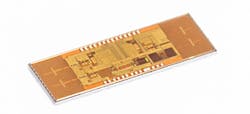Imec Demonstrates 140-GHz CMOS Radar-on-Chip with Integrated Antennas
At the recent International Microwave Symposium in Philadelphia, Imec announced development of what it says is the world’s first CMOS 140-GHz radar-on-chip system with integrated antennas in standard 28-nm technology.
“With our prototype radar, we have demonstrated all critical specs for radar technology in 28-nm standard CMOS technology,” said Wim Van Thillo, program director at Imec. “We are well advanced in incorporating multiple antenna paths in our most recent generation solution, which will enable a fine angular resolution of 1.5 cm in a complete MIMO radar form factor of only a few square centimeters. We expect this prototype in the lab by the end of 2018, at which point our partners can start building their application demonstrators.”
Imec’s radar-on-chip features integrated antennas. (Source: Imec)
The Leuven, Belgium research organization’s solution employs a proprietary two-antenna, single-input, single-output (SISO) radar transceiver chip and a frequency-modulated continuous-wave phase-locked loop (FMCW PLL), stock off-the-shelf ADCs, an FPGA, and a MATLAB chain. The transceiver features on-chip antennas achieving a gain said to be close to 3dBi. The transmitter boasts an effective isotropic radiated power (EIRP) that exceeds 9 dBm and a receiver noise figure of below 6.4 dB. Total power consumption for the transmitter and receiver is less than 500 mW, which can be further reduced by duty cycling, according to Imec.
The FMCW PLL enables fast slopes up to 500 MHz/ms over a 10-GHz bandwidth around 140 GHz, with a slope linearity error below 0.5%. The FPGA contains real-time implementation of basic radar processing functions such as fast Fourier transforms (FFTs) and filters, and is complemented by a MATLAB chain for detections, constant false alarm rate (CFAR), direction-of-arrival estimation, and other radar processing functions.
First applications are expected to include remote-car driver vital-signs monitoring and gesture recognition for man-machine interactions. There can be as many as three radar systems in today’s vehicles equipped with ADAS functions. Fully automated cars may require six to 10 radar systems as well as additional sensor systems using camera imaging and/or LiDAR technologies.


